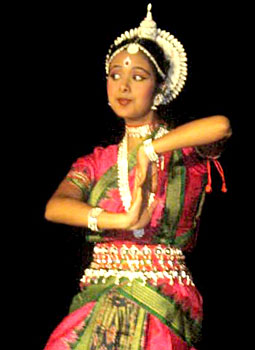 The word Pallava means to elaborate. It is applicable not only to the dance but also to the music which accompanies it. The movements in this item are extremely graceful and lyrical, and music and rhythm are given equal importance in the item as the dance proper. In the beginning the raga-rupa or ragamurti of a particular raga on which the Pallavi music is based is sung by the vocalist as noted, in the Orissan texts on music. The Sanskrit sloka describing the murti or image is enacted by the dancer. This is the only sequence of nritya in this item. Then a line of ukuta is sung basing on the notation of the particular raga and the dancer keeping beats on the foot does rhythmic movements of the eyes, eyebrows and the neck known as nakhi. After this, a number of pure nritta sequences follow successively with stylised poses movements. Intermittently different swara patterns and tala patterns are worked out through various movements.
The word Pallava means to elaborate. It is applicable not only to the dance but also to the music which accompanies it. The movements in this item are extremely graceful and lyrical, and music and rhythm are given equal importance in the item as the dance proper. In the beginning the raga-rupa or ragamurti of a particular raga on which the Pallavi music is based is sung by the vocalist as noted, in the Orissan texts on music. The Sanskrit sloka describing the murti or image is enacted by the dancer. This is the only sequence of nritya in this item. Then a line of ukuta is sung basing on the notation of the particular raga and the dancer keeping beats on the foot does rhythmic movements of the eyes, eyebrows and the neck known as nakhi. After this, a number of pure nritta sequences follow successively with stylised poses movements. Intermittently different swara patterns and tala patterns are worked out through various movements.
After each pattern the dancer returns to the basic stance thai to start another. It has been noted that there are two varieties of Pallavi i.e. Swara-Pallavi and Vadya-Pallavi. But practically Pallavi is one in which both swara and tala is given equal importance and the patterns relating to them are found together. Pallavis are known after their ragas on which they are based. Most popular among them are Basanta Pallavi, Kalyana Pallavi and Mohana Pallavi. Some Gurus have added few more Pallavis to the repertory in other ragas.
This article is a stub. You can enrich by adding more information to it. Send your Write Up to content@indianetzone.com



















